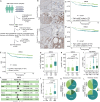Cyclin E1 overexpression triggers interferon signaling and is associated with antitumor immunity in breast cancer
- PMID: 40101803
- PMCID: PMC11927439
- DOI: 10.1136/jitc-2024-009239
Cyclin E1 overexpression triggers interferon signaling and is associated with antitumor immunity in breast cancer
Abstract
Background: Cyclin E1 overexpression drives oncogenesis in several cancers through deregulation of DNA replication and induction of genomic instability, which may potentially trigger immune signaling via cytoplasmic DNA. However, the effects of cyclin E1 overexpression on tumor immunity and its effects on the response to immune checkpoint inhibitors remain largely unclear.
Methods: Tissue microarrays and clinical outcomes of 398 patients with breast cancer were analyzed to explore the correlation between cyclin E1 expression, patient survival, and immune cell infiltration using immunohistochemistry. Genomic data from publicly available data sets and three clinical trials evaluating immunotherapy were assessed to measure the impact of cyclin E1 expression on the immune cells in the tumor microenvironment and response to immunotherapy in patients with breast cancer. In addition, breast cancer cell lines with inducible cyclin E1 overexpression were employed to analyze the effects of cyclin E1 on inflammatory signaling.
Results: Increased cyclin E1 expression in breast cancer was positively correlated with immune cell infiltration, including T cells, B cells, and natural killer cells, and activation of interferon-related pathways. Importantly, higher cyclin E1 expression or CCNE1 amplification was associated with better response to immunotherapy in three clinical trials. Mechanistically, cyclin E1 overexpression resulted in micronuclei formation and activation of innate immune signaling, resulting in increased immune cell migration.
Conclusions: Our data show that cyclin E1 overexpression associate with antitumor immunity through activation of innate inflammatory signaling and warrants investigation into amplification or overexpression of cyclin E1 in identifying patients with breast cancer eligible for immunotherapy.
Keywords: Breast Cancer; Immunotherapy.
© Author(s) (or their employer(s)) 2025. Re-use permitted under CC BY-NC. No commercial re-use. See rights and permissions. Published by BMJ Group.
Conflict of interest statement
Competing interests: BvdV reports honoraria received by UMCG for expertise or scientific advisory board/consultancy (on request): Visiopharm, Philips, MSD/Merck, Daiichi-Sankyo/AstraZeneca; Speaker’s fee from Visiopharm, Diaceutics, MSD/Merck. Personal fees from DEKRA. All unrelated to the current manuscript. All other authors declare no competing interests.
Figures




References
MeSH terms
Substances
LinkOut - more resources
Full Text Sources
Medical
